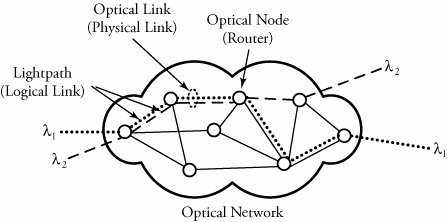Section 14.1. Overview of Optical Networks
14.1. Overview of Optical NetworksOptical fibers can transmit digitized light signals over long distances because of the purity of glass fiber combined with improved electronics technology. With some acceptable transmission loss, low interference, and high-bandwidth potential, an optical fiber is almost an ideal transmission medium. Optical communication systems may sometimes be combined with electrical components . In such systems, electrical data bits are converted into light, using a certain wavelength ; when the transmission is completed, the optical signal is converted back to an electrical signal, which is then passed to higher layers that manage switching, restoration, and grooming. Optical networks can provide more bandwidth than regular electronic networks can. Major advantages of partial optical networks are gained by incorporating some electronic switching functions. The optical network shown in Figure 14.1 consists of optical nodes interconnected with physical optical links . A point-to-point physical optical link may consist of several logical paths called lightpaths , each carrying a different wavelength. A lightpath is set up by assigning a dedicated wavelength to it. The data can be sent over the lightpath once it is set up. A lightpath can create virtual neighbors out of nodes that may be geographically far apart in the network. A lightpath uses the same wavelength on all fiber links through which it passes . Figure 14.1. Overview of an optical network 14.1.1. Protocol Models and StandardsOptical networks provide routing, grooming, and restoration of data at the wavelength level and developed from the emergence of the optical layer in the transport and network layers. The challenges of optical networks are network management in the presence of different wavelengths and keeping the cost down to be able to add new services. An optical network's agility gives it the speed and intelligence required for efficient routing. Thereby improving network management and faster connections and network restorations. For an optical system with many channels on a single fiber, a small fiber cut can potentially initiate multiple failures, causing many independent systems to fail. Several standards apply in the optical communication environment. The widely used synchronous optical network (SONET) standard provides the transport infrastructure for worldwide telecommunications and defines interface standards at the physical layer of the protocol stack. SONET also defines a hierarchy of interface rates that allow data streams at different rates to be wavelength multiplexed. SONET establishes optical carrier (OC) levels ranging from level 1 at 51.8 Mb/s (OC-1) to level-192 at 9.95 Gb/s (OC-192). Communication carriers throughout the world use this technology to interconnect their existing digital carriers and fiber optic systems. In optical networks, client layers and optical layers are managed separately, with no direct interaction between the clients and optical-layer equipment. A centralized network-management system provides optical-layer connections. However, distributed control protocols are used to handle network protection and restoration. Because of the centralized management scheme for connection provisioning, a network may not be reliable. From a control and management perspective, there is a great deal of interest in obtaining a closer interaction between the network layer and the optical layer. Two popular models are the overlay model and the peer model . In the overlay model, the optical layer and the network (IP) layer have their own independent control planes. Here, the client layer interacts with the optical layer through a user -to-network interface (UNI), and optical-layer elements talk to each other through a network-to-network interface (NNI). In an overlay model, the optical network topology is hidden from the client layer through UNI. In the peer model, the network layer and the optical layer run the same control-plane software. Routers have full topology awareness of the optical layer. But the peer model is complicated because the optical layer imposes significantly different constraints from those on the IP layer. This elegant model has a closer coupling between the IP layer and the optical layer. |
EAN: 2147483647
Pages: 211
